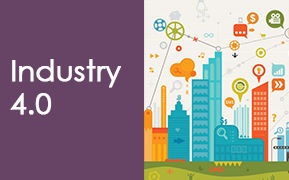Industry 4.0

In our previous article we discussed the Tactile Internet (see article here) which is something borne from research and study into the perceived fourth industrial revolution, or industry 4.0 as it is referred to. Let’s explore industry 4.0, and how it will change and shape our lives henceforth. What is the fourth industrial revolution? Firstly, we need to recap the previous three in brief.
What are the previous revolutions?
Beginning around 1760, the industrial revolution surrounded the invention and development of the steam engine. Very quickly everything from agriculture to textile manufacturing was transformed, and the country moved away from its agrarian roots, where the economy was mostly centred around arable farming and livestock. The second industrial revolution came when science was mixed into industry and for the first time items or products could be mass produced. The pioneer of this advance was Henry Ford who was able to mass produce the model T car. The third revolution was the digital revolution: starting in the 1950s, this brought such advances as mainframe computing, semi-conductors and, more importantly, the internet.
The Fourth Revolution
The term industry 4.0 is a subset from the fourth revolution, and specifically applies to the change in industries and manufacturing where new technologies have been applied. These include, but are not limited to smart manufacturing, smart factories, lights out manufacturing and the internet of things. Industry 4.0 was first cited and recognised by the German government in 2011 as part of their high-tech strategy and their attempts to fully computerise manufacturing. Their strategy set out four specific goals and they are as follows.
1) Interconnection: the ability of machines, devices, sensors, and people to connect and communicate with each other via the Internet of Things (IoT) or the Internet of People (IoP)
2) Information transparency: the transparency afforded by Industry 4.0 technology provides operators with vast amounts of useful information needed to make appropriate decisions. Inter-connectivity allows operators to collect immense amounts of data and information from all points in the manufacturing process, thus aiding functionality and identifying key areas that can benefit from innovation and improvement.
3) Technical assistance: first, the ability of assistance systems to support humans by aggregating and visualising information comprehensively for making informed decisions and solving urgent problems on short notice. Second, the ability of cyber physical systems to physically support humans by conducting a range of tasks that are unpleasant, too exhausting, or unsafe for their human co-workers.
4) Decentralized decisions: the ability of cyber physical systems to make decisions on their own and to perform their tasks as autonomously as possible. Only in the case of exceptions, interferences, or conflicting goals, are tasks delegated to a higher level.
Intrinsically and based on these goals, smart factories will be at the heart of Industry 4.0. Machines will have the ability to collect vast amounts of data in real time, extrapolate relevant information and autonomously utilise artificial intelligence to self-manage and regulate their performance and tasks. They will be able to speed up and slow down production themselves, as well as order maintenance tasks to be carried out automatically. The benefit of this to factories is that it can deliver enormously superior cost efficiencies to the standard, in addition to higher production and quality levels. Although the initial outlay for such technology is massive, the rewards for industry are considerable and if adopted widely it will stamp out inefficiency at all levels.


